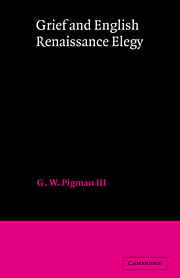Book contents
- Frontmatter
- Contents
- Acknowledgments
- Introduction
- Chapter 1 The Angry Consoler
- Chapter 2 The Emergence of Compassionate Moderation
- Chapter 3 Praise and Mourning
- Chapter 4 The Shift from Anxious Elegy
- Chapter 5 Surrey and Spenser
- Chapter 6 Jonson and King
- Chapter 7 Milton
- Conclusion
- Notes
- Bibliography
- Index
- Frontmatter
- Contents
- Acknowledgments
- Introduction
- Chapter 1 The Angry Consoler
- Chapter 2 The Emergence of Compassionate Moderation
- Chapter 3 Praise and Mourning
- Chapter 4 The Shift from Anxious Elegy
- Chapter 5 Surrey and Spenser
- Chapter 6 Jonson and King
- Chapter 7 Milton
- Conclusion
- Notes
- Bibliography
- Index
Summary
It is a long way from Erasmus' or Wilson's efforts to suppress grief with shame or guilt to the letter of condolence, a long way from Becon's complete condemnation of sorrow to. Cole's sympathy for the process of mourning. It is a long way from Grimald's anxious attempt to justify a grief which he hardly expresses to the intimate sorrow of King's ‘Exequy’ or the angry protests and gentle consolation of ‘Lycidas’. It is even a long way from Spenser's ‘November’, to take a major poem by a major precursor in the same genre, to ‘Lycidas’, once one recalls how Colin's consoling vision of Dido in heaven leads him to reflect on human wretchedness and folly. Nevertheless, the striking differences between Grimald and King or between Spenser and Milton should not be taken to imply that by the time of Milton all English elegists are free from anxiety about grief and pour out heartfelt expressions of sorrow. One need only recall Thomas Farnaby's poem in the collection in which ‘Lycidas’ first appeared.
Lessus inanes mittite ergò & naenias:
Virtute cassos impii & stulti fleant;
Lugere felices nefas est & furor.
So stop your empty laments and dirges. Let the impious and foolish weep for those lacking in virtue. It is sacrilege and madness to mourn for the blessed.
- Type
- Chapter
- Information
- Grief and English Renaissance Elegy , pp. 125 - 127Publisher: Cambridge University PressPrint publication year: 1985



